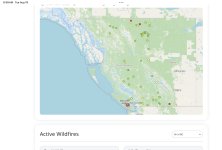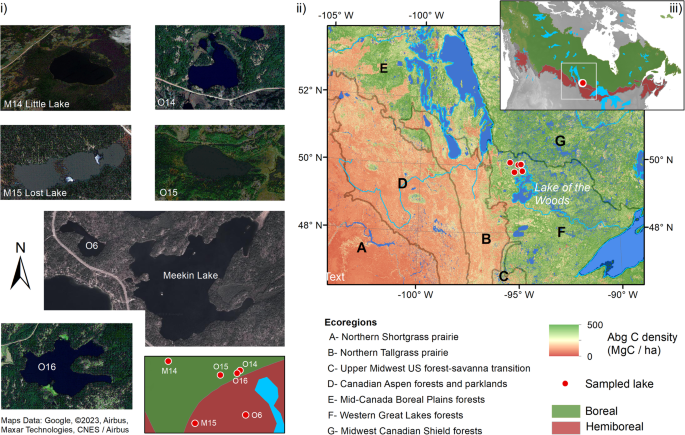- Reaction score
- 790
- Points
- 910
Algonquin Provincial Park is 770,000 ha
The largest single tenure I can find in Ontario is the Abitibi Forest near Cochrane at 3,285,435 ha in size.
Assuming harvesting cuts around 0.5% per year of each land base that works out to 15% of the area cleaned up via logging/reforestation each 30 years (a generational intervention as the Scandinavians call it). So
Assuming I put an experiences saw man into the forest and he cuts/cleans up 1 ha per day...
and works 275 days a year...
Area x 85% / 275 work days /3 generational interventions =
I need to find roughly 730 folks willing to work just to deal with Algonquin Provincial Park working full time...
Or ~3,350 people to deal with the Abitibi Forest. But there's only 5,400 people there according to Wikipedia.
Now assuming they're working for $50k/year (just making my math simple) and taxes/EI/WCB/etc. add another 50% in costs to the employer...
That's close to $50,000,000 just for Algonquin Park
And google tells me the entire Ontario Wildfire Budget is only $130,000,000. But there's also some emergency funding to account for fire costs so it's actually more like $330,000,000 total funds available. Doesn't really matter...fact is taxpayers can't afford the costs it would take to deal with the Crown Lands.
And even if you do the work there will still be fires so it's not as simple as cleaning up the forest.
That being said what I could see working much more effectively is a much stricter and visible approach to zoning with both carrots and sticks involved.
1) you want the rustic camp/cottage in the trees and have dead forest all over your lands? Your property will be formally inspected and declared a low priority assets to try to protect (this is already happening within some municipal areas in Canada where they are tagging properties in advance of disasters especially in slow/off season conditions). Sucks but we need to quit wasting dollars and sucking up resources trying to protect buildings that are cheaper to rebuild that spend suppression costs on. Especially when they might not be insured in the first place.
2) get serious about building codes for homes/building in the wildland urban interface. Cedar shingles look nice...but burn better. Follow more the Australian changes where renovations/new builds require updated standards and insurance breaks are provided for those properties.
3) Look at small co-gen power generation. The amount of building construction waste from the City of Toronto alone should allow for enough fuel to feed at least a small facility. Chipped material is more efficient than lumber scraps/tree trunks but a single chipper can deal with a lot of material. Make this free to drop off if it's clean (i.e. scrap lumber is okay...drywall still attached is not).
4) Get serious about doing burning in lower hazard conditions. This will require more crews/resources in the shoulder seasons but there also needs to be more work done to build up cooperative burn groups with First Nations, loggers, parks, and communities. This is a really tough one to do but will require re-examining who can start fires, when, and how...and what liabilities are assigned to each burn. Can think of several First Nations I work with who could burn safely on their reserve or nearby...but need us there for liability in case something goes wrong.
5) encourage more managed forest on private lands....what is the minimum size to be considered managed? Is the number different in the north vs south? Could it be as simple as windbreaks cumulatively adding up to be a couple of acres...and then changing the taxes from residential lands to agricultural if kept clean? Big tax implications but also possible reduced costs for suppression.
6) We need to do a much better job at explaining nature and history. The Abititi Forest cited above and the town of Cochrane have a long history of fire. Heck Wikipedia tells me the town was burnt in 1910, 1911, and 1916. Cochrane, Ontario - Wikipedia. So it's been a hundred years and the forest is not the same as that of my father's or grandfathers youth. Some of these big fires are not just climate change but also 100 years of wildfire suppression, mature forest starting to fall apart with 100 years of fuel load in there, and a history of having large fires in the area. So start teaching what should be more "normal" and less of the dramatization of "massive fires everywhere".
The largest single tenure I can find in Ontario is the Abitibi Forest near Cochrane at 3,285,435 ha in size.
Assuming harvesting cuts around 0.5% per year of each land base that works out to 15% of the area cleaned up via logging/reforestation each 30 years (a generational intervention as the Scandinavians call it). So
Assuming I put an experiences saw man into the forest and he cuts/cleans up 1 ha per day...
and works 275 days a year...
Area x 85% / 275 work days /3 generational interventions =
I need to find roughly 730 folks willing to work just to deal with Algonquin Provincial Park working full time...
Or ~3,350 people to deal with the Abitibi Forest. But there's only 5,400 people there according to Wikipedia.
Now assuming they're working for $50k/year (just making my math simple) and taxes/EI/WCB/etc. add another 50% in costs to the employer...
That's close to $50,000,000 just for Algonquin Park
And google tells me the entire Ontario Wildfire Budget is only $130,000,000. But there's also some emergency funding to account for fire costs so it's actually more like $330,000,000 total funds available. Doesn't really matter...fact is taxpayers can't afford the costs it would take to deal with the Crown Lands.
And even if you do the work there will still be fires so it's not as simple as cleaning up the forest.
That being said what I could see working much more effectively is a much stricter and visible approach to zoning with both carrots and sticks involved.
1) you want the rustic camp/cottage in the trees and have dead forest all over your lands? Your property will be formally inspected and declared a low priority assets to try to protect (this is already happening within some municipal areas in Canada where they are tagging properties in advance of disasters especially in slow/off season conditions). Sucks but we need to quit wasting dollars and sucking up resources trying to protect buildings that are cheaper to rebuild that spend suppression costs on. Especially when they might not be insured in the first place.
2) get serious about building codes for homes/building in the wildland urban interface. Cedar shingles look nice...but burn better. Follow more the Australian changes where renovations/new builds require updated standards and insurance breaks are provided for those properties.
3) Look at small co-gen power generation. The amount of building construction waste from the City of Toronto alone should allow for enough fuel to feed at least a small facility. Chipped material is more efficient than lumber scraps/tree trunks but a single chipper can deal with a lot of material. Make this free to drop off if it's clean (i.e. scrap lumber is okay...drywall still attached is not).
4) Get serious about doing burning in lower hazard conditions. This will require more crews/resources in the shoulder seasons but there also needs to be more work done to build up cooperative burn groups with First Nations, loggers, parks, and communities. This is a really tough one to do but will require re-examining who can start fires, when, and how...and what liabilities are assigned to each burn. Can think of several First Nations I work with who could burn safely on their reserve or nearby...but need us there for liability in case something goes wrong.
5) encourage more managed forest on private lands....what is the minimum size to be considered managed? Is the number different in the north vs south? Could it be as simple as windbreaks cumulatively adding up to be a couple of acres...and then changing the taxes from residential lands to agricultural if kept clean? Big tax implications but also possible reduced costs for suppression.
6) We need to do a much better job at explaining nature and history. The Abititi Forest cited above and the town of Cochrane have a long history of fire. Heck Wikipedia tells me the town was burnt in 1910, 1911, and 1916. Cochrane, Ontario - Wikipedia. So it's been a hundred years and the forest is not the same as that of my father's or grandfathers youth. Some of these big fires are not just climate change but also 100 years of wildfire suppression, mature forest starting to fall apart with 100 years of fuel load in there, and a history of having large fires in the area. So start teaching what should be more "normal" and less of the dramatization of "massive fires everywhere".






